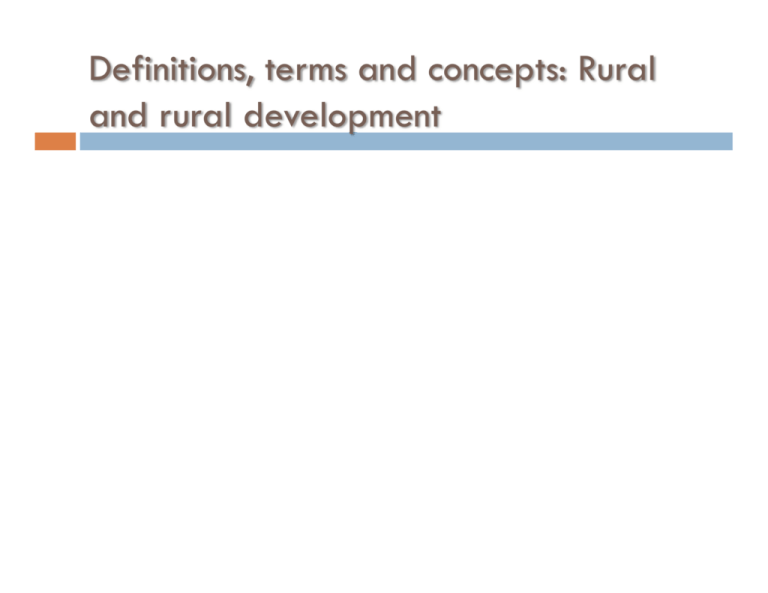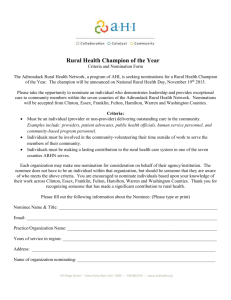
Definitions, terms and concepts: Rural
and rural development
Rural: Definitions
From Wikipedia: Rural areas are large and isolated
areas of an open country with low population density.
From Wikipedia: Rural development in general is used
to denote the actions and initiatives taken to improve
the standard of living in non-urban neighborhoods,
countryside, and remote villages. These communities can
be exemplified with a low ratio of inhabitants to open
space. Agricultural activities may be prominent in this
case whereas economic activities would relate to the
primary sector, production of foodstuffs and raw
materials.
Rural population: Global context
Percent Rural Population
80
Global Population
United Nations, Department
of Economic and Social
Affairs, Population Division
World Urbanization
Prospects: The 2009
Revision
File 2: Percentage of
Population Residing in
Urban Areas by Major
Area, Region and Country,
1950-2050
POP/DB/WUP/Rev.2009/
1/F2
All rights reserved.
70
60
50
40
30
20
10
0
1950
1970
1990
2010
Year
2030
2050
http://esa.un.org/unpd/wup/index.htm
100
80
60
0
China, Hong Kong SAR
Bermuda
Malta
American Samoa
Chile
Gabon
South America
Canada
Mexico
More developed regions
Czech Republic
Iran (Islamic Republic of)
Ukraine
Dominica
Iraq
South Africa
Dem. People's…
Croatia
Georgia
Ghana
Mayotte
Less developed…
Less developed…
Asia
Maldives
Zimbabwe
Zambia
Saint Kitts and Nevis
Guinea-Bissau
Lesotho
Afghanistan
Nepal
Trinidad and Tobago
Rural population: Global context
Puerto Rico (1%)
Percent Rural Population by Country 2010 (estimated)
US (18%)
Mexico (22%)
Canada (19%)
40
20
http://esa.un.org/unpd/wup/index.htm
Definitions of rural: US
United States Census (2000 census) defines rural areas as comprising open
country and settlements with fewer than 2,500 residents
(population/administrative-based); areas designated as rural can have
population densities as high as 999 per square mile or as low as 1 person
per square mile (population/land use-based).
United States Department of Agriculture (2002 farm bill) defines rural
areas as any area other than (1) a city or town that has a population of
greater than 50,000 inhabitants, and (2) the urbanized areas contiguous
and adjacent to such a city or town.
United States Office of Management and Budget defines a Metropolitan
Statistical Area as consisting of (1) central counties with one or more
urbanized areas (as defined by the Census Bureau) and (2) outlying
counties that are economically tied to the core counties as measured by
worker commuting data (i.e. if 25% of workers living there commute to the
core counties, or if 25% of the employment in the county consists of workers
coming from the central counties). Non-metro counties (rural counties) are
outside the boundaries of metro areas.
Definitions of rural: US
Definitions of rural: US
Why do these definitions matter?
Targeting
of development programs and allocation of
and eligibility of funds from the programs and depends
on how rural areas are classified.
For example, targeting of assistance programs for
education, access to medical services, poverty
alleviation, and broadband expansion depends on the
status of these services in an area.
Eligibility for assistance programs will depend on
whether an individual is classified as living in a rural
area.
US Rural Demographics
Rural Population Indicators for United States, 2000
Census Places with a
Rural is defined as areas outside…
population ≥
2,500 10,000 50,000
Population
Total population considered rural
(million)
87.7
115.8
177
U.S. total
281.4
Percent of population considered rural
31.1
41.1
62.9
N/A
Percent of land area considered rural
Population density (people/sq mile)
97
25.6
97.9
33.4
99
50.5
N/A
79.6
USDA National and State Indicator Tables http://ers.usda.gov/Data/RuralDefinitions/indicators.htm
US Rural Demographics
Rural is defined as areas Census Places with a
outside…
population ≥
U.S. total
2,500 10,000 50,000
Age
Percent younger than 18
Percent 19 to 64
Percent 65 or older
Ethnicity
Percent non-Hispanic Black
Percent American Indian
Percent Hispanic
26
61.5
12.5
25.9
61
13.1
25.7
61.1
13.1
25.6
61.9
12.4
6.9
1.2
5
7.2
1.1
5.8
8.3
0.9
7.8
12
0.7
12.5
US Rural Demographics
Census Places with a
Rural is defined as areas outside…
population ≥
2,500 10,000 50,000
Education
U.S. total
Percent not completing high school
19.2
19.1
18.4
19.6
Percent completing high school only
Percent with only some college
33.7
20.4
33.1
20.5
31.2
21
28.6
21
Percent with a college degree or higher
Income
26.8
27.3
29.4
30.7
Average household income ($1,000)
56
56
57
57
Percent in near-poverty households
8
8.2
8
8.6
Percent in below-poverty households
9.9
10.3
10.5
12.4
Percent in deep-poverty households
4.1
4.3
4.5
5.6
US Rural Demographics
Census Places with a
Rural is defined as areas outside…
population ≥
2,500 10,000 50,000
Employment
Percent in agriculture, forestry, fishing,
hunting, mining industries
4
3.5
2.6
Percent traveling > 1/2 hour to work
Housing
Percent seasonal housing
Percent without complete plumbing
Houshold composition
Percent 65 and older and living
alone
Percent of children under 18 in
female-headed household
U.S. total
1.9
10.3
9.9
9.8
10.4
7
2
6.2
1.7
4.7
1.3
3.3
1.2
25
26.4
27.2
28.2
13.5
14.9
16.5
20
US Rural: Recent trends
US Rural: Recent trends and
geographic distribution
Place Matters: Challenges and
Opportunities in Four Rural Americas
Amenity-rich rural US
New, growing populations.
Predominantly white non-Hispanics, but with a growing Hispanic
population.
Employment is relatively high and poverty is low.
Many households are upper-middle to upper class.
Almost one-half the respondents had college degrees, and one-third had
college-educated fathers—much more than other areas.
Household incomes and home values are higher than other areas, too,
and many properties are second homes.
Survey respondents note the natural environment as a very important
reason for moving to their community.
They worried about climate change, and favored rules to restrict
development and conserve natural resources.
Declining resource-dependent rural US
Respondents were overwhelmingly white non-Hispanic.
Most are long-term residents whose parents also grew up in this area.
Out-migration, particularly by young adults, drives population decline in these
counties. The older generations stay behind, the population ages, and family size
shrinks
Poverty is low, and employment is very high, with many reporting a second job.
Respondents in these counties were most likely to be married, to participate in
local organizations, to believe their neighbors will help out when needed, to
most consistently attend weekly religious services, and to vote Republican.
Few declining-area respondents moved to the area for its natural beauty, and
their participation in outdoor recreation (other than hunting) was low.
They did not see sprawl as a problem, and were less worried about climate
change or resource conservation.
Declining population, jobs, and drug manufacturing or sales were the most
prominent local problems.
Place Matters: Challenges and
Opportunities in Four Rural Americas
Chronically poor rural US
High birth rates somewhat offset out-migration, and population decline has been
gradual.
The areas comprised substantial African-American populations, with more young
adults and fewer elders than in other areas.
The great majority were long-term residents whose parents grew up in the area.
Employment was relatively low, and poverty much higher than in the other areas.
These areas had the highest share of residents with less than a high school
education.
Respondents were least likely to be married, participated the least in local
organizations, and were more heavily Democratic.
Respondents reported frequent religious activity
Environment and land use were not seen as problemss.
Few chronic- poverty respondents moved to their region for its natural beauty,
and a relatively large minority favored using natural resources to create jobs
rather than conserving those resources.
Residents in were concerned about crime, drugs and unemployment.
Definitions of rural: Mexico
Following the criteria in force in Mexico and established
by the Political-Administrative Division, municipalities
are classified into three groups:
urban municipalities with a population over 15,000
semi urban municipalities with a population of 2,500 to
15,000
rural municipalities with populations less than 2,500
inhabitants.
The urban-rural classification is an approach that is
often used in the formulation of policies, administrative
organization, the allocation of budgetary resources, or
the targeting of programs.
Place Matters: Challenges and
Opportunities in Four Rural Americas
Mexico: Rural trends
In the 20th century, population in Mexico passed
from a predominantly rural population to
predominantly urban.
In1950,
57% of the population lived in rural localities.
In 2000, 25% of the population lived in rural localities.
However, the process of urbanization has not been
consistent across the country: while more than 90%
of the population of the Distrito Federal is urban,
less than half the population in Oaxaca, Chiapas
and Hidalgo states live in urban localities.
Mexico: Geographic distribution
Degree of urbanization by state, 2002
Degree of Urbanization
Predominately urban >89%
Very urban 80 - 89.9%
Urban 67 – 79.9%
Semi-urban 59 – 66.9%
Source: INEGI, in: Government of the United Mexican States, Second
Report of Government, September 1, 2002
Rural < 59%
Mexico: Poverty level
http://siteresources.worldbank.org/INTMEXICO/Resources/A_Study_of_Rural_Poverty_in_Mexico.pdf
Mexico: Sources of income
http://siteresources.worldbank.org/INTMEXICO/Resources/A_Study_of_Rural_Poverty_in_Mexico.pdf
Mexico: Age distributions
Rural Population, 2000
>65
60-64
55-59
50-54
45-49
40-44
35-39
30-34
25-29
20-24
15-19
10-14
5-9
0-4
Men
Women
Urban Population, 2000
>65
60-64
55-59
50-54
45-49
40-44
35-39
30-34
25-29
20-24
15-19
10-14
5-9
0-4
Men
Women
Source: INEGI, in: Government of the United Mexican States, Second Report
of Government, September 1, 2002, President of the Republic, Mexico, 2002.
Mexico: Examples of rural assistance
programs
Most programs for human development in rural areas is managed by
SEDESOL, Secretaria de Desarrollo Social.
Oportunidades: Purpose is to reduce extreme povertyby providing
monetary support to families in this situation, in the areas of education,
health, nutrition and energy costs.
Piso Firme: Seeks to benefit families living in houses with dirt floors,
replacing it with concrete floor thereby improving their housing and living
conditions.
IMSS-Oportunidades: Purpose is to provide health services free to people
in socially and economically disadvantaged who live in remote areas.
Vivienda Rural: The aim is to support the expansion or improvement of
homes.
Caravanas de la Salud: Purpose is to health services to remote communities
through mobile medical units.
www.presidencia.gob.mx
Definitions of rural: Canada
du Plessis, V., Beshiri, R. Bollman, R. and Clemenson, H. (2002) “Definitions of ‘Rural,” Agriculture and Rural Working Paper Series Working
Paper No. 61, Statistics Canada, Agriculture Division, Ottawa, Canada.
Definitions of rural: Canada
Canada: Rural trends
Canadian provinces
Canada: Geographic distribution
Canada: Employment
Employment by Major Industrial Sectors in Rural and
Small Town areas, Canada, 1998
Accomodation, food and beverages
Other services
Health services
Primary (agriculture, mining, forestry,…
Manufacturing
Wholesale and retail trade
0
200
400
Employment (thousands)
600
Canada: Employment
Employment by type of region, 1996
Canada
All predominantly rural
regions
Intermediate regions
Predominantly urban regions
60%
65%
70%
75%
Employment/Population ages 15 to 64
Canada: Availability of health care
Urban
Semi-urban
Rural and small towns
Canada: Availability of health care
moving further north
Dr. Ivan P. Fellegi
Chief Statistician of Canada
Canada: Age distribution
September, 1996
Understand
ing Rural
Canada:
Structures
and Trends
Dr. Ivan P.
Fellegi
Chief
Statistician
of Canada
September,
1996
Canada: Education
Understand
ing Rural
Canada:
Structures
and Trends
Dr. Ivan P.
Fellegi
Chief
Statistician
of Canada
September,
1996
Canada: Ethnicity
Understand
ing Rural
Canada:
Structures
and Trends
Dr. Ivan P.
Fellegi
Chief
Statistician
of Canada
September,
1996
Canada: Income
Understand
ing Rural
Canada:
Structures
and Trends
Dr. Ivan P.
Fellegi
Chief
Statistician
of Canada
September,
1996







